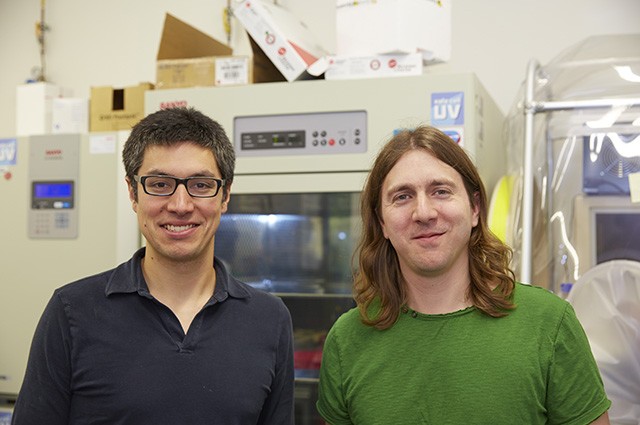
Destination collaboration
In the first of a series of interviews catching up with visitors to EMBL, we speak to Stanford University’s Kerwyn Casey (KC) Huang, a biophysicist who wants to develop a global picture of how cells are constructed.

Peering into the microbial world to understand how cells are built, KC Huang is not afraid to confront the big questions that lie far beyond the universe of his tiny research subjects. A physicist from Stanford University, Huang is currently joining forces with EMBL Heidelberg group leader Nassos Typas with the goal of bridging the research landscape between the physics and biochemistry of cell growth. In town for three more months, after winning the Friedrich Wilhelm Bessel (FWB) Research Award – an award given by the Alexander von Humboldt Foundation to internationally renowned scientists to spend a sabbatical period in institutions in Germany –, Huang combines imaging approaches and modelling to study bacteria of all shapes and sizes. He aims to systematically map cellular development in different contexts and across scales, from molecules to ecosystems to evolution.
KC, what are you working on?
My group is focused on the physical constraints that guide the challenge of building cells. We want to answer questions such as: How do cells grow? How do they determine their shape? How do molecules get to the right place at the right time? Cell shape plays a critical role in regulating many physiological functions, yet little is known about how the wide variety of cell shapes are determined and maintained. The diverse world of bacteria provides a great platform for us to explore these questions and our work is heading in exciting directions, particularly in delivering insights into cell metabolism and evolution. I am a theoretical physicist by training, but I was drawn to biology when thinking about how cells develop and how their morphology and organisation affect how they function: what really fascinates me is that there are so many different ways to attack these problems.
I am still a theoretical physicist at heart: I want to understand what is possible and how things work.
What do you hope to achieve during your time at EMBL?
Together, Nassos and I want to connect our knowledge about the physics and biochemistry of cell growth. While my group is focussed on architectural problems such as how the cell wall is built and the mechanics of cell division, research in Nassos’s group looks to understand bacterial lifestyle, how species interact, and how stresses and the environment affect cellular development. The FWB Research Award aims to bring together people with different, but complementary, skills for long enough so that our approaches can really rub off on one another. My stay at EMBL will allow us to think about new questions, using different tools, and will literally bring new dimensions to the respective problems we are interested in.
What are your first impressions?
At Stanford University, any time I want to learn something, I have complete confidence that there’s someone out there who is working on it and is willing to teach me. EMBL has a similar feel – the atmosphere is young, ambitious and incredibly dynamic, and people across the Lab are continuously building on, sharing and benefiting from each other’s expertise. From a scientific point of view, EMBL is incredibly well aligned with the research direction of my group: increasingly, we want to extend our studies into systems biology, integrating and building knowledge of interactions of key modules inside the cell. I am sure there will be many mutually beneficial exchanges with the different groups here.
Describe something or someone that has inspired your work
When Erwin Schrödinger raised the big question in his book What is Life? more than seventy years ago, very little was known about how cells function at the molecular level. And while many of the notions that he wrote about have been superseded by modern science, his thought experiments integrating biology, physics, mathematics and chemistry introduced ideas that still frame how we see life today. My group is investigating how a cell is constructed: ultimately, we want to build a molecular picture from the bottom up to predict how millions of molecules fit together and interact. But answering this huge question also requires a top down approach – much like Schrödinger’s – where we infer, based on observations at different cellular scales, what kinds of rules are either necessary or sufficient to enable cell growth to be robust.
Ultimately, we want to build a molecular picture from the bottom up to predict how millions of molecules fit together and interact.
What are you excited about going forward?
One of the most exciting aspects of the work we do in our group is that we can begin to tell a story of cellular construction, from atoms all the way up to the cell as a whole. Computational and systems biology is reaching a golden age where researchers are really beginning to build the tools needed to answer how cellular interactions give rise to such complex behaviour. But I am still a theoretical physicist at heart: I want to understand what is possible and how things work. Physics can provide a strong set of constraints to measure how these interactions generate particular functions. Pushing deeper into the fundamental workings of life relies on combinations of very different expertises, something that makes my stay at EMBL particularly exciting. Here, I can just walk down the corridor and find biologists, physicists, chemists and scholars from many other fields – it creates a remarkable synergy.
KC Huang will give an external faculty speaker seminar at EMBL Heidelberg on the 6 May.


